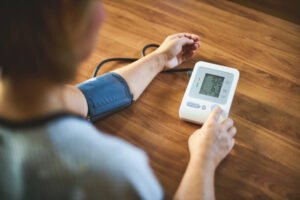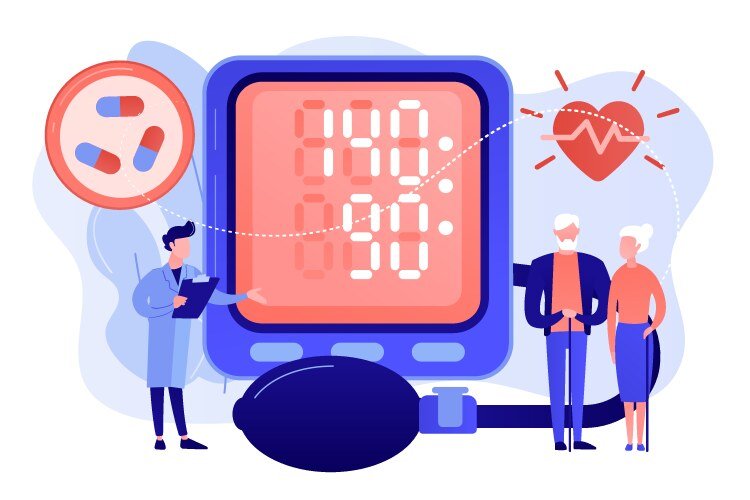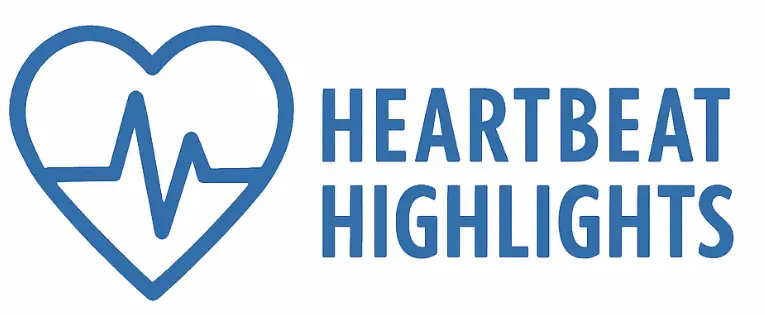Your complete guide to understanding systolic, diastolic, and the ranges that define a healthy blood pressure.
Why Blood Pressure Numbers Matter
 When your doctor or nurse checks your blood pressure, they’re giving you two numbers—like “120 over 80.” The first number, called systolic, measures the pressure in your arteries when your heart beats. The second, diastolic, measures the pressure when your heart rests between beats. Together, they tell an important story about how hard your heart is working and how well your blood vessels are handling the flow of blood.
When your doctor or nurse checks your blood pressure, they’re giving you two numbers—like “120 over 80.” The first number, called systolic, measures the pressure in your arteries when your heart beats. The second, diastolic, measures the pressure when your heart rests between beats. Together, they tell an important story about how hard your heart is working and how well your blood vessels are handling the flow of blood.
These numbers matter because blood pressure isn’t just a random measurement—it’s one of the most reliable indicators of your cardiovascular health. When blood pressure stays in the healthy range, your arteries remain more flexible, your heart doesn’t have to work as hard, and your risk of heart attack, stroke, and kidney disease stays lower.
But if blood pressure rises, even slightly, it can silently damage your arteries over years. This damage builds up without symptoms, which is why high blood pressure is often called the “silent killer.” Understanding your numbers is the first step in protecting your long-term health.
What the Numbers Mean: From Healthy to Dangerous
Leading organizations like the American Heart Association (AHA), the American College of Cardiology (ACC), and the European Society of Cardiology (ESC) agree on the general categories of blood pressure. While the exact labels and thresholds may vary slightly, the message is the same: lower is generally better—within reason.
Normal (<120/80 mmHg)
This is considered the optimal range for most adults. Your heart and blood vessels are under minimal strain, and your risk of cardiovascular disease is at its lowest. If your readings consistently fall in this category, it’s a sign that your circulatory system is in excellent shape. Maintaining normal blood pressure over decades can significantly reduce the chance of developing heart problems, stroke, and kidney issues later in life.
Elevated (120–129 mmHg systolic and <80 mmHg diastolic)
Think of this range as a gentle warning light. You’re not in the high blood pressure category yet, but your numbers are above the ideal. Elevated blood pressure often means your arteries are starting to experience more pressure than is healthy, which can lead to gradual stiffening and narrowing. Without changes in daily habits, many people in this category will progress to hypertension within a few years.
High Blood Pressure, Stage 1 (130–139 mmHg systolic or 80–89 mmHg diastolic)

At this stage, your cardiovascular system is under more constant strain. The risk for heart disease, stroke, and kidney damage begins to rise measurably. You may still feel perfectly fine—high blood pressure rarely causes symptoms—but the damage to arteries and organs can already be starting. Doctors typically recommend closer monitoring and, depending on your overall risk profile, may suggest lifestyle adjustments or additional testing to catch early signs of complications.
High Blood Pressure, Stage 2 (≥140 mmHg systolic or ≥90 mmHg diastolic)
This is a more serious level of hypertension where the strain on your heart and blood vessels is significant. The risk of complications—such as heart attack, stroke, heart failure, and chronic kidney disease—increases sharply. At this stage, blood pressure is less likely to be managed by monitoring alone, and most people require medical intervention to protect their long-term health.
Hypertensive Crisis (>180/120 mmHg)
This is a medical emergency. Such high pressure can quickly damage vital organs and trigger life-threatening events like a stroke, heart attack, or acute kidney failure. Immediate medical attention is critical—call emergency services rather than waiting for it to come down on its own.
Why "Lower" Isn’t Always Better
It’s true that staying below the high blood pressure threshold is essential, but experts caution against aiming for extremely low numbers—especially in certain groups.
The ESC and AHA/ACC guidelines both note that for most adults, a systolic reading of 110–119 mmHg and diastolic of 70–79 mmHg is excellent. However, going much lower—such as below 100/60 mmHg—can cause dizziness, fainting, and reduced blood flow to organs. This is particularly relevant for older adults, people with heart valve problems, or those taking multiple blood pressure-lowering medications.
Blood pressure targets should be individualized. For example:
- Younger, healthy adults may benefit from lower readings without side effects.
- Older adults or people with certain heart conditions may need slightly higher targets to avoid complications from overly low pressure.
The key is finding your personal “sweet spot” where your heart and arteries are protected, but your body still receives the blood flow it needs.
The Importance of Accurate Measurement
Even the most carefully set targets are meaningless if your readings aren’t accurate. Many factors—some as simple as crossing your legs—can alter your numbers. To ensure reliability:
- Rest before measuring. Sit quietly for at least 5 minutes. Stress, rushing, or recent activity can cause temporary spikes.
- Position matters. Keep both feet flat on the floor, your back supported, and your arm at heart level.
- Use the right cuff size. A cuff that’s too small will give falsely high readings; one that’s too large can underestimate your blood pressure.
- Avoid stimulants beforehand. Skip caffeine, nicotine, and intense exercise for 30 minutes before checking your blood pressure.
- Measure multiple times. One reading is just a snapshot. Taking 2–3 readings in the morning and evening over several days gives a more accurate picture of your average.
Home monitoring—when done correctly—can be more representative of your true blood pressure than a single clinic measurement. It helps you and your healthcare provider see patterns and detect changes early.
The Takeaway: Healthy Blood Pressure Is About Balance
A healthy blood pressure isn’t just a number on a chart—it’s a range that reflects your body’s ability to move blood efficiently without overworking your heart or damaging your arteries. For most adults, less than 120/80 mmHg is the goal, but your exact target should be discussed with your healthcare provider, taking into account your age, overall health, and any medical conditions.
By understanding what the numbers mean, you can be proactive. Regular checks, accurate measurements, and informed discussions with your doctor are the best ways to stay in the safe zone for years to come.
References
- American Heart Association. Understanding Blood Pressure Readings. Available at: https://www.heart.org/en/health-topics/high-blood-pressure
- American College of Cardiology/American Heart Association. 2017 Guideline for the Prevention, Detection, Evaluation, and Management of High Blood Pressure in Adults. J Am Coll Cardiol. 2018;71:e127–e248.
- European Society of Cardiology/European Society of Hypertension. 2023 ESC/ESH Guidelines for the management of arterial hypertension. Eur Heart J. 2023;44(32):2739–2891.
Disclaimer
This article is for educational purposes only and is not a substitute for professional medical advice, diagnosis, or treatment. Always seek the advice of your physician or other qualified health provider with any questions you may have regarding your health or a medical condition. Never disregard professional medical advice or delay seeking it because of something you have read here.









